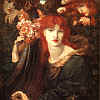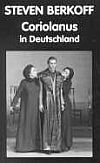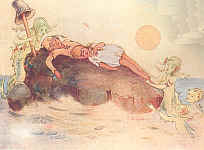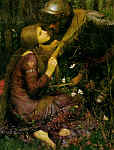|
home
advanced |
Figuring Figuration by
Deborah Knight III Figuring the Fiction of Fact I originally thought it would be logical to start my discussion with a genealogy of Steven Berkoff’s work, little imagining that such an enterprise would lead me back faster than expected to the thesis in question: the figuring of figuration. In 1.2, I stated my intention to use Berkoff’s own documentation of himself as the basis of my analysis, thinking that his autobiography and director journals would supply first hand information as to the historical influences that could be said to have predetermined his contribution to our literary and theatrical heritage. They do indeed, and yet, rather than allow me to simply list these influences, the particular nature of these texts obliged me first to question certain assumptions I held concerning the traditional separation of reality from fiction, leading me to change my conception of Berkoff’s genealogy from that of an affirmation of his identity to that of a system of tropes that serve to assemble a discursive persona. However, Berkoff’s awareness of this construction is signaled throughout by the use of various other figures, making us reconsider the time-honoured erroneous notions about genre which imbue the autobiography or journal with a guarantee of truth we would never expect to find in their ‘opposing’ category of fiction, except, perhaps, through our desire to read into those works the private life and opinions of the author. Let us look at how Berkoff succeeds in shaking our blind belief in the reality of the autobiographical author and our hope of finding his or her presence in fiction through his own singular appropriation of various literary genres that claim, to a greater or lesser degree, to be autobiographical. Although this approach may seem to deviate from the original thesis of figuring figuration and Berkoff’s work, it reveals itself to be at the very hub of the matter if we consider the fact that probably his greatest work of art is that of the marketable identity he is currently figuring in the caption to the home page of his official web site: ‘Steven Berkoff: legendary actor, director, playwright, author’. 3.1 Figuring the fiction of fact in literary genre
The heartfelt interpolation (have we seen that word before somewhere?) occurs, as if ‘he’ [Ref 1-01] can no longer restrain himself, mid-sentence, right in the middle of explaining the outcome of Harry’s clear insight that it was to be his and the young woman’s ‘destiny’ to play a scene from A Streetcar Named Desire together, during the course of their Working Man Institute acting classes. The sudden deictic telescoping effect of the distant ‘they’ giving way to the abrupt intimacy of ‘you’ and ‘I’ cannot fail to momentarily startle the reader:
Who could this narrator be who disappears every bit as summarily as he appeared, never to reappear again? All fingers would be pointing at Berkoff himself if they belonged to the hands of those who have read his autobiography Free Association. Therein they would have read that, like Harry, the twenty-year old Berkoff also found ‘a sanctuary’ (53), not at the Working Man’s Institute but at the City Literary Institute, where an out-of-work actor and his mime teacher, a disciple of Jacques Lecoq, taught him the skills he needed for the art, which, again as for Harry, was not merely ‘a hobby’ as it was for most of the other students, but ‘the means whereby the oaken laurel might one day be placed on his head’ (Graft: Tales of an Actor, “Audition” 12). Does Berkoff, issue of East End working class immigrant Russian-Jews, mention Wosemawee with her ‘aura of faded gentility’ (13) in his autobiography? No, although there are plenty of other auburn-haired beauties that appear between the covers, taking up a sentence or a page or two here or there before moving out of his life. Nevertheless, the only one who is not only called a pre-Raphaelite beauty but could also fit the Wosemawee description of being ‘elegantly, classically, intelligently beautiful’ (13) is his beloved Anne ‘Chittle’ (who, incidentally, is neither described as red-haired nor Alice-in-Wonderland-like, but as having long silken hair and as being ‘out of Peter Pan crossed with Rossetti’ {304}), with whom he says he lived for four blissful years in the early seventies before she ran off with the ‘Polish lodger’ (Coriolanus in Deutschland 117) who lived in the house he bought at that time. He never tells us if he ever heard from her again. Quite apart from these implicit similarities, Berkoff’s frequent assertions that his writing is above all autobiographical [Ref 1-02] make it reasonable to assume that this interpolation is simply a more literary device for showing his authorial presence to be alive and kicking within the subject matter of the text, leading us to wonder if he might be assuming an anti-postmodernist stance. ‘I very rarely needed to research to find themes or seek for “subjects”’, says he, on page four of his autobiography, ‘since take it or leave it the subject has been myself’. If we take Berkoff’s indirect assertion that the ‘Harry’ stories of Gross Intrusion are in one way or another autobiographical (as implied in his words quoted in Ref 1-02), and add it to his comments about wanting to ‘write Christmas out of [his] being for all time’ (Free Association 353) by detailing four days in the life of a lonely man ‘who felt the way [he] did’ (356) in his one-man show “Harry’s Christmas”, we would be all the more justified for believing the narrator and the Harry of the stories of Graft: Tales of an Actor to be Berkoff and his literary alter ego respectively. Perhaps, but the fact that his ‘gross intrusion’ follows hot on the heels of an allusion to ‘that famous scene’ in A Streetcar Named Desire makes one ponder upon the quality of that authorial presence a moment. He never tells us which ‘famous scene’ he is referring to, but the context, coupled with the evocative character of his own invasive interpolation, would rather seem to suggest the scene leading up to the elliptical rape scene. If we consider the literary implications of that rape to be a form of physical metaphor for the clashing of two opposing agendas - the unmarried genteel woman’s desperate plying of her fading charms in order to buy time in a patriarchy that has no place for her, and the working class male’s instinctive use of the physical to reinstate his dominance over his territory - and apply it to Berkoff’s interpolation, it would seem to point to an author ‘raping’ the fiction of his own text. Whether this fiction has autobiographical elements or not becomes neither here nor there, for in this view it is now its literary elevation that is being shown to be denigrated by pointing to its real life ‘authenticity’ [Ref 1-03] in what seems at first to be a reversal of Baudrillard’s extreme postmodernist notion of art totally penetrating reality. I find ready corroboration of this interpretation on page 222 of the author’s autobiography where he states that he was ‘distraught at the plight of Blanche Dubois’ when he first saw the movie of A Streetcar Named Desire. The subsequent statement seems to further indicate which of the two combatants – fiction or fact - the author ultimately champions, over and above his narcissistic ‘impulsions’: ‘while I naturally studied Stanley Kowalski, a part I might have liked to play one day and nearly did, I still found the character of Blanche far more interesting and multi-dimensional, as she was intended to be until Brando stole the limelight’ (222). Of course, it is tempting to interpret Berkoff’s disapproval of the real life actor exerting his dominance over the fictional character as coinciding with my deduction. There again, if we reconsider the evidently premeditated aspect of the textual ‘knot’ this aforementioned interpolation creates, it would seem to reinstate the manipulative power of the author, thereby reaffirming, à la Harold Bloom [Ref 1-04], his significance in creating the individuality of the text. This could lead us to suspect him of consciously and strategically triggering the readers’ Pavlovian interpretive processes, in order to show them up to be the rapists of the text. But that would nevertheless continue to make him the original abuser whose actions provoke the culminating rape of his own text. Although that may still relegate him to Roland Barthes’ ‘electric chair’, it would at least restore to him the capacity to press the button that kills him. That may well be, but as we shall see this very passage that seems to affirm the author’s presence in the midst of fiction simultaneously and ostentatiously carries with it the tools of his autobiographical deconstruction, as if Berkoff is figuratively reconstructing himself in fiction as fast as he should be deconstructed in ‘reality’. We will come back to this, but for the time being let us have a look at another case that not only draws attention to our blind faith in the literary conventions of the truth value of certain genres, but also, once again, smacks of reader manipulation. This time, instead of intruding upon his story telling in order to simulate the fundamental incompatibility of fact amidst fiction, Berkoff now seems to be purposely casting doubt on what is traditionally perceived as a bona fide account of a life due to its prescriptive generic packaging.
As a sort of sub-plot to the day-to-day progress of the play, he occasionally alludes to the fact that he is falling in love with a woman, whom we understand to be the one he mysteriously refers to as ‘C’, and is considering getting divorced in order to marry her. A signifier such as ‘C’ almost demands a de-coding and I set to with a will, much in the manner of the State interpreters Gulliver tells an academy projector about in “A Voyage to Laputa” who decode private letters in order to discover heinous plots. While they deciphered the word ‘sieve’ to stand metaphorically for ‘court lady’ (Gulliver’s Travels and Other Writings 155), the sentence ‘our brother Tom has got the piles’ to be an anagram for ‘resist – a plot is brought home – the tour’ (156) and the acrostic ‘n’ to mean ‘plot’ (156), I proudly uncovered the letter ‘C’ to stand for the ‘Clara’ he dedicated Meditations on Metamorphosis and Graft: Tales of an Actor to, on the basis of their publication dates, 1995 and 1998, falling posteriorly to this budding romance in 1988 [Ref 1-05]. However, the two sudden appearances of the full name ‘Clara’ [Ref 1-06], sandwiched between many allusions to ‘C’, give rise to doubt this interpretation, even though in both instances her name is associated to information we have already learnt about C. In the first instance, having told us he considers no one to be funnier than C [Ref 1-07], he carefully reports to us the sort of humorous remark Clara would make in a particular situation [Ref 1-08]. Then, after describing himself as being ‘like a junkie’ (136) who has to make a flying visit to London for the weekend in order to obey a ‘needful obsession’ (136) that will mean having to forego seeing C in Hof, the second instance of his evocation of Clara mirroring that of C is made slightly more explicit. The sentence ‘When we [Ref 1-09] took off I saw the glorious sun-baked green countryside and I regretted that I wouldn’t walk in the woods with C this weekend’ (136) is followed soon after by this one in the present tense of the reported interior monologue that precedes it: ‘I look over Clara’s Germany and wish I hadn’t done it!’ (137).
Quite apart from the fact that C seems to live in Hof, in Germany, Berkoff’s usual hankering for her company hardly calls to mind the urgent passions aroused by the siren he wishes he could break with in Brighton, running as it does more along the lines of ‘gentle walks and talks’ (127). However, no further mention is made of Brighton, and Berkoff eventually knuckles down to the last week of work with the reassuring thought that C will soon join him in Munich. Although we are treated to the classical ‘happy ending’ with Berkoff and C tranquilly reunited for his opening night and walking out of the theatre ‘into the warm, balmy air’ (160) afterwards together, the reader is left feeling slightly perplexed at the ripples those textual tensions created in an otherwise smooth read. Perplexed and annoyed, for, at the end of the day, does he or she really care if there was one woman, or two or three? The slightly bitter aftertaste of this reading is not one of curiosity blighted but of feeling forced into running down blind alleys. Is this a case of extremely poor writing - and poor editing -, or savant manipulation on Berkoff’s part? The overall quality of his writing would seem to indicate the last. And if that is the case, does this peculiar literary device not rather place his characters (or perhaps we should say his ‘tripartite heroine’) and himself more aptly in the realm of the fictional? If so, that would oblige us to reconsider the nature of the Clara of his book dedications. I have heard rumours of her existence, but how can we be so sure? Perhaps she is just another character or a sort of decorative figurehead that adorns the prow of his books, luring readers on to believe in the reality of its fictions? There is certainly no mention of her in his autobiography published in 1996, although he does refer to his ‘present wife’ a few times. But there again, if he is capable of making us question the existence or at least the actions of others who figure in his director journals, and even of turning Coriolanus into a sort of romance à l’eau de rose (which itself just misses a threatening turn towards the x-rated), it may be wise to reconsider the way in which we should read his own personal figuration, in those same journals and in his autobiography, too.
3.2 The fiction of the reality
of autobiographical characters If I said earlier that ‘Berkoff’s’ interpolation in the short story “Audition” ostentatiously carries with it the very tools of his deconstruction, it is because I am convinced that it appears so flamboyantly swathed in literary and cultural cross-references intentionally, to force us into noticing them. Moreover, the very nature of those references seem to be purposely chosen to flaunt before our noses the evidence that any resolution as to the enigmatic identity of their instigator may only be achieved through the creative interpretation of first and second degree innuendo and ellipsis simply to arrive at nothing more than suggestive approximations. Let me explain. Having already been led to think of Berkoff himself by the uncanny resemblance of the opening events of this short story to his own early adult life as described in his autobiography, the interpolation that follows simply motivates this inclination further by inciting me to look for a woman in this presumably factual or referential text who may have held equal importance for him as Wosemawee held for Harry. The fact that the interpolation occurs within the context of a literary allusion to a film implicitly likening Harry to Stanley Kowalski leads me to further fortify my conviction by comparing Berkoff’s working class origins with those of Stanley Kowalski. Having discovered the autobiographical mode of description used for his ex-girlfriend (or first wife?) Chittle to concur with that of the fictional Wosemawee, as I will explain in a moment, the lack of information as to whether or not she and Berkoff have kept in touch in the intervening years since she left him lends itself admirably to my purposes, allowing me to interpret the ellipsis of this information in such a way as to make it concur with the author’s – oops, sorry… the narrator’s – passionately nostalgic rhetorical address to a Wosemawee he has not seen in years. Thanks to the prescriptive power of Chittle’s figuration in the autobiography, I now have sufficient ‘evidence’ conclusively to flesh out the intruding phantasm of the text with the defining traits of the author. If I were not so eager
to continue with this train of thought, perhaps I would
pay a little attention to a certain residual sense of
discomfort that is not dispelled by the overall logic of
my self-congratulatory conclusion. If I were to take
another look, I would be obliged to admit that my initial
argument which attempted to furnish the interpolation
with authorial purpose (thereby validating it and
restoring my belief in the quality of Berkoff’s
writing), is not only based on the conjecture that the
scene Harry is referring to in A Streetcar Named
Desire is indeed the rape scene, but even more
gravely on the faith that the characters he and Wosemawee
were to play were indeed those of Stanley Kowalski and
Blanche Dubois. Actually, even before we get to those
assumptions, it has to be admitted that my entire
argument hangs rather precariously upon the assumption
that the character Harry was consciously conceived by
Berkoff in order to symbolize his literary alter ego. With a bit of luck, the ‘real life’ Chittle may save my interpretation, once again. We cannot deny her likeness to her fictional counterpart Wosemawee, especially if we consider the distinctive characteristic they share of being described by way of their resemblance to various fictional characters. While we can infer that Harry saw Wosemawee as a cross between Blanche Dubois and Alice in Wonderland, Berkoff refers to Chittle as being ‘out of Peter Pan crossed with Rossetti’ (Free Association 304). If we consider this particularity in the light of feminist theory, we can easily supply an explanation as to why the first comparison between fictive female characters is readily accessible to our understanding, while the second, entailing a real woman, solicits active interpretation in order to decode the unstated ‘somethings’ to which the signifiers ‘Peter Pan’ and ‘Rossetti’ liken her. If anything, this aping of the patriarchal convention that rules that a male signifier should determine female identity can only give my comparison of Chittle to Wosemawee greater credibility, as she is thereby shown as descending that prior step of cultural figuration before bathing in the same intensity of literary figuration as her fictive ‘look-alike’.
If
we reflect on Berkoff’s following allusion to
Chittle,
in Coriolanus in Deutschland - a book we have seen to share the above women’s predilection for fantasy - and bear in mind the convention that Tinkerbell will only continue to exist if we believe in her, we could wonder if we are not being led to doubt Chittle’s real-life existence despite her appearance in Berkoff’s autobiography. These doubts can so readily be endorsed by the suspiciously literary nature of some of the components in the above sentences: the literary ring to the ‘Polish lodger’ calls to mind characters out of Dickens or Kafka, while Berkoff’s unexplained assertion that he finally realized that his beloved Chittle was doing him a favour to leave him can only remind us of the sort of highly nonsensical remark one could expect to find in the confessions section of a Women’s Own; a remark that nevertheless succeeds in conferring upon its enunciator an aura of mystery and importance thanks to the elliptical information it leaves dangling so tantalizingly in the air. Or maybe we do not have to go quite so far as to doubt Chittle’s existence per se. Perhaps the peculiar nature of the figures Berkoff uses to breathe life into her are his way of obliging us to look again at the form her configuration takes: first, that she is described through the medium of literary or cultural allusion; second, that the girl-women she is likened to are only alluded to, in good true patriarchal form, via the initial evocation of men; third, that the majority of the interpretive work that finally endows her textual marker with evocative presence is undertaken by the reader in an effort to fill in the ellipses that mark the spaces where the girl-women who made up her identity should have been found. Rather than doubt Chittle’s physical existence, maybe we are simply being asked to look at her textual representation again to see how very fabricated, how very subjective, and how very ephemeral the resulting image the reader creates is. In a word, how very fictive. © Deborah Knight 2001 |





